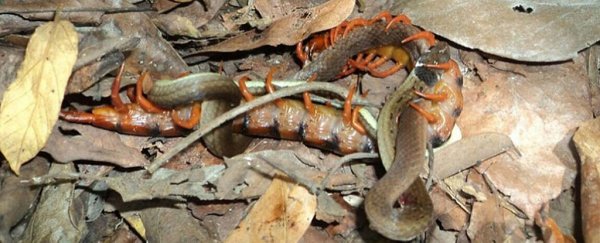From the seedy underbelly of the natural world where invertebrates prey on anything they can get their fangs on, we have brand new nightmare fuel - giant centipedes crunching away on snakes.
A team of biologists in Thailand has reported the "fortuitous observation" of a centipede attacking a snake, made all the more disturbing by the fact the clawed creature chose a moment when the snake was at its most vulnerable - while it was laying eggs.
Horror-pedes belonging to the vicious Scolopendrid group are known to eat not just their typical fare of insects, but also various vertebrates. The nocturnal, multi-legged creatures spanning up to 10 cm (4 in) have been caught prowling on rat babies in nests, lizards, bats, and even birds.
Biologists believe this behaviour is largely opportunistic, rather than a staple of the centipede diet - and centipede-vs-snake action is quite a rare sight.
But this time, the team at Thailand's Sakaerat Environmental Research Station hit quite the jackpot when they came across a wriggly monstrosity in the dry leaves of the forest underscrub.
"The centipede was found already wrapped along the whole body of the snake, which was caught during oviposition, with three eggs already having been laid, and another two seemingly still inside its body," the team writes in the paper.
To keep its victim still, the centipede had it grappled in its claw-like legs, and for good measure stabbed it with venomous claws known as forcipules - a special appendage-turned-weapon that's characteristic only of centipedes.
In what we consider a smart move, the scientists didn't disturb the scene, but took plenty of photographs which helped them identify the species.
They determined that the murderous centipede was Scolopendra dawydoffi, a large and aggressive species common in Southeast Asia, and the snake in its deadly embrace was the triangled black-headed snake (Sibynophis triangularis).
What makes this incident a biologist's jackpot is the snake's defenceless position - it was in the middle of depositing a clutch of eggs.
"Our report is the first known incident of a vertebrate prey being caught while laying eggs," the team brags in the report.
As they explain, snake females are at their most vulnerable during this egg-laying process, so the centipede chose to strike at a particularly opportunistic moment, "taking advantage of this particular situation from which the animal could not escape."
The scientists conclude that based on their observation and previous reports in the literature, it's possible giant centipedes eat vertebrate prey more often than we assumed, because the nutritional payoff from a juicy snake or toad would be significant over a measly cricket or beetle.
If you still have any appetite left, there was also that time a centipede got eaten by a snake and, instead of accepting its fate, gnawed its way out from the inside. You're welcome.
The report was published in the Journal of Insect Behaviour.
